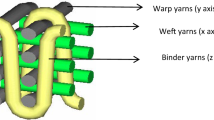Abstract
Deformable boring bar is the executive component of embedded giant magnetostrictive actuator (GMA), which plays a key role in the output performance of embedded GMA in precision machining of non-cylindrical piston pinhole. In this paper, a multi-parametric coupling design method was presented for deformable boring bar and giant magnetostrictive material. Firstly, the dynamic model of deformable boring bar was built. Second, the performance index of length-diameter ratio was introduced, and the problem of multi-parametric coupling design was solved by using the idea of nonlinear programming. The first-order natural frequency, the end output displacement and the output force of deformable boring bar were taken as the evaluation indexes to ensure the performance requirements of embedded GMA. Finally, according to project requirements and proposed method, an embedded GMA with high frequency response and large output displacement was further designed, which met the performance requirements of displacement and stiffness in precision machining of non-cylindrical piston pinholes and also verified the validity of the design method.















Similar content being viewed by others
References
Meng, Y. & Fu, L. (2010). Application and development research on giant magnetostrictive apparatus. In: 2010 2nd International Conference on Mechanical and Electronics Engineering (pp. 442–445).
Lei, W., Jiu, B. T., & Shan, Z. (2010). A giant magnetostrictive actuator based on use of permanent magnet. International Journal of Advanced Manufacturing Technology, 46(9–12), 893–897.
Kwak, Y. K., Kim, S. H., & Ahn, J. H. (2011). Improvement of positioning accuracy of magnetostrictive actuator by means of built-in air cooling and temperature control. International Journal of Precision Engineering and Manufacturing, 12(5), 829–834.
Zhang, L., Wu, Y. J., Liu, X. L., & Wang, B. (2012). Linearity hysteresis model of giant magnetostrictive components for non-cylindrical hole precision machining. Optics and Precision Engineering, 20(2), 287–295.
Xu, H. B., Zhang, T. L., Jiang, C. B., & Zhang, H. (2005). Giant magnetostrictive actuator and its application in active vibration control. In: The Fifth Pacific Rim International Conference on Advanced Materials and Processing (pp. 2089–2094).
Zhai, P., Zhang, C. R., & Lan, H. B. (2006). Study on development trend and machining technology of odd-shaped pinhole of automotive high-load piston. Automobile Technology, 3, 39–43.
Wu, Y. J., & Liu, C. H. (2004). Study on design approach of giant magnetostrictive actuator. Journal of Zhejiang University (Engineering Science), 38(6), 96–99.
Noh, M. D., & Park, Y. (2012). Topology selection and design optimization for magnetostrictive inertial actuators. Journal of applied physics, 111(7), 1–3.
Fan, W., Lin, M., Ju, X., & Wang, Q. (2017). Magneticfield calculation and simulation of a cylindrical giant magnetostrictive actuator. Journal of Functional Materials, 48(5), 05054–05060.
Zhao, Z. R., Wu, Y. J., Gu, X. J., Zhang, L., & Yang, J. F. (2009). Multi-physics coupling field finite element analysis on giant magnetostrictive materials smart component. Journal of Zhejiang University (Engineering Science), 10(5), 653–660.
Zhang, L., Wu, Y. J., Liu, X. L., & Wang, B. (2012). Multi-field coupling model of embedded giant magnetostrictive components optimization. Transactions of the Chinese Society for Agricultural Machinery, 43(5), 190–196.
Mao, P. F., Yu, C. F., Wang, C. L., & Zhong, C. M. (2017). Structure design and optimization of flexure hinge positioning stage based on giant magnetostrictive actuator. Journal of Mechanical Transmission, 41(3), 74–77.
Zhou, X., Zuo, C., Liu, Q., Wang, R., & Lin, J. (2016). Development of a double-frequency elliptical vibration cutting apparatus for freeform surface diamond machining. International Journal of Advanced Manufacturing Technology, 87(5–8), 2099–2111.
Kim, M., Lee, D. W., Lee, S., Kim, Y., & Jung, Y. (2017). Effects of hinge design of horizontal-swing fast tool servo (HFTS) for micro-patterning on a roll. International Journal of Advanced Manufacturing Technology, 95(1–4), 233–241.
Dao, T., & Huang, S. (2010). Compliant thin-walled joint based on zygoptera nonlinear geometry. Journal of Mechanical Science and Technology, 31(3), 1293–1303.
Xu, P., Yu, J., Zong, G., & Bi, S. (2010). An effective pseudo-rigid-body method for beam-based compliant mechanisms. Precision Engineering, 34(3), 634–639.
Wang, S., Rong, W., Wang, L., Pei, Z., & Sun, L. (2017). Development of a novel long range piezoelectric motor based on double rectangular trajectories driving. Microsystem Technologies, 24(12), 1–10.
Lobontiu, N., Paine, J. S. N., Garcia, E., & Goldfarb, M. (2002). Design of symmetric conic-section flexure hinges based on closed-form compliance equations. Mechanism and Machine Theory, 37(5), 477–498.
Yong, Y. K., & Lu, T. F. (2008). The effect of the accuracies of flexure hinge equations on the output compliances of planar micro-motion stages. Mechanism & Machine Theory, 43(3), 347–363.
Huang, S., & Dao, T. (2016). Design and computational optimization of a flexure-based XY positioning platform using FEA-based response surface methodology. International Journal of Precision Engineering and Manufacturing, 17(8), 1035–1048.
Shaw, M.C. (1984). Metal cutting principles. New York: Oxford University Press.
Acknowledgements
The research was funded by the National Natural Science Foundation of China (No. 51275462), and the Zhejiang Province Basic Public Welfare Research Project (No. LGG18E080006).
Author information
Authors and Affiliations
Corresponding author
Additional information
Publisher's Note
Springer Nature remains neutral with regard to jurisdictional claims in published maps and institutional affiliations.
Rights and permissions
About this article
Cite this article
Peng, H., Xu, H., Wu, Y. et al. Research on Multi-Parametric Coupling Design Method of Deformable Boring Bar in Embedded Giant Magnetostrictive Actuator. Int. J. Precis. Eng. Manuf. 21, 2287–2297 (2020). https://doi.org/10.1007/s12541-020-00414-9
Received:
Revised:
Accepted:
Published:
Issue Date:
DOI: https://doi.org/10.1007/s12541-020-00414-9




